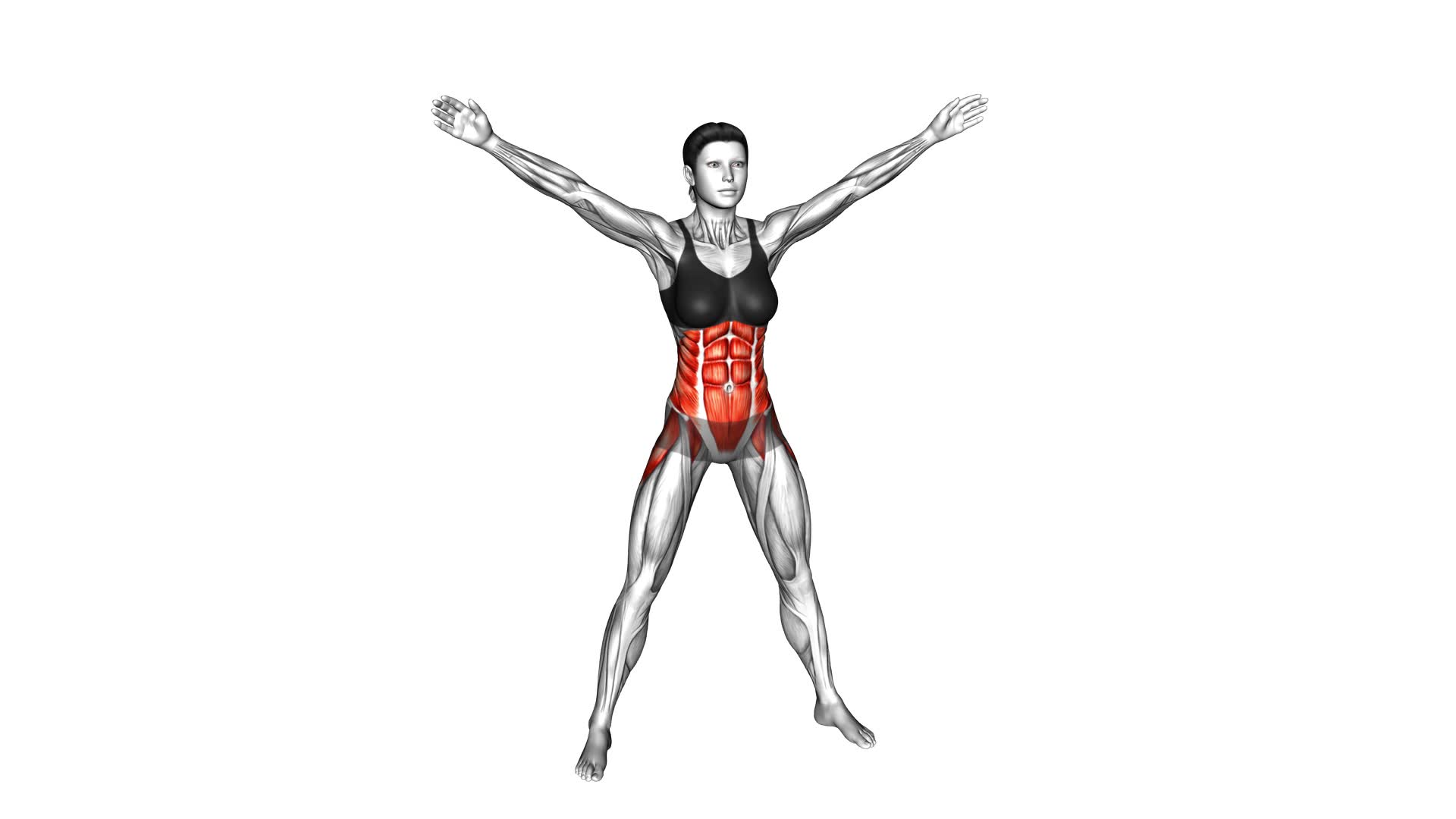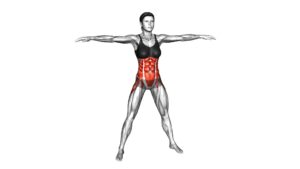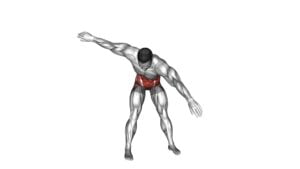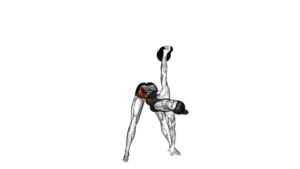Bodyweight Windmill Cut (female) – Video Exercise Guide & Tips

Are you looking for a challenging yet effective exercise to add to your workout routine? Look no further than the Bodyweight Windmill Cut!
Watch This Exercise Video
This video exercise guide and tips will show you the proper alignment, form, and modifications for all fitness levels. Plus, you'll learn breathing techniques for maximum results and common mistakes to avoid.
Whether you're a beginner or advanced, the Bodyweight Windmill Cut is a great addition to your fitness journey.
Let's get started!
Key Takeaways
- The Bodyweight Windmill Cut strengthens the entire core and improves flexibility.
- It increases stability in the shoulders and hips, enhancing overall body coordination and balance.
- Proper alignment and form include maintaining a straight line from head to toe, keeping knees soft and core engaged, and lifting the chest while keeping the head in line with the spine.
- Modifications are available for all fitness levels, such as starting with lighter weights or no added resistance for beginners and using heavier weights or dynamic variations for advanced individuals.
Benefits of the Bodyweight Windmill Cut
To maximize the effectiveness of your workout, you can incorporate the bodyweight windmill cut, which offers numerous benefits when performed correctly. This exercise not only strengthens your entire core, but also improves your flexibility and increases stability in your shoulders and hips. By engaging multiple muscle groups simultaneously, the bodyweight windmill cut helps to improve overall body coordination and balance.
One of the key benefits of the bodyweight windmill cut is its ability to enhance your core strength. As you rotate your torso and lift your leg, your abdominal muscles, obliques, and lower back are all engaged, resulting in a stronger and more stable core. This can help improve your posture and reduce the risk of back pain.
In addition to core strength, proper alignment and form are crucial when performing the bodyweight windmill cut. By maintaining a straight line from your head to your toes, you ensure that each movement is executed correctly. This not only maximizes the effectiveness of the exercise but also helps to prevent injuries.
Proper Alignment and Form
Ensure proper alignment and form by maintaining a straight line from head to toe while performing the bodyweight windmill cut. Proper alignment is crucial to maximize the effectiveness of this exercise and prevent injury. Here are some alignment tips and form techniques to help you get the most out of the bodyweight windmill cut.
Start by standing with your feet slightly wider than shoulder-width apart, toes pointing slightly outwards. Keep your knees soft and your core engaged throughout the movement. As you begin to lower your body towards the ground, hinge at the hips and push your glutes back, maintaining a neutral spine. Your weight should be evenly distributed on both feet.
As you lower your body, keep your chest lifted and your head in line with your spine. Avoid rounding your shoulders or collapsing forward. Your arms should be relaxed and extended in front of you, parallel to the ground. This will help to counterbalance the movement and maintain stability.
As you come back up to the starting position, focus on pushing through your heels and engaging your glutes to power the movement. Maintain control and avoid using momentum to swing your body up.
Modifications for All Fitness Levels
Now let's talk about modifications for all fitness levels.
Scaling bodyweight exercises allows you to adjust the intensity based on your abilities. Beginners can adapt the windmill cut by starting with lighter weights or performing the movement without any added resistance.
On the other hand, advanced individuals can challenge themselves by using heavier weights or incorporating more dynamic variations of the exercise.
Scaling Bodyweight Exercises
How can you modify bodyweight exercises for all fitness levels?
Scaling bodyweight exercises is an effective way to adapt for beginners and accommodate different fitness levels. Here are four ways to modify bodyweight exercises:
- Reduce the intensity:
Beginners can start by performing exercises at a lower intensity or with less resistance. For example, instead of doing full push-ups, start with knee push-ups or incline push-ups using a bench or wall.
- Modify the range of motion:
Gradually increase the range of motion as your strength and flexibility improve. For squats, start with partial squats and gradually progress to deeper squats.
- Use assistance or support:
Incorporate props like resistance bands or stability balls to assist with balance and provide additional support during exercises.
- Increase repetitions or duration:
Beginners can focus on increasing the number of repetitions or the duration of each exercise gradually over time, as they build strength and endurance.
Remember to always listen to your body and progress at a pace that feels challenging yet manageable.
Adapting for Beginners
To adapt bodyweight exercises for beginners and accommodate different fitness levels, you can make modifications in several ways.
Beginner modifications are important to ensure that individuals who are new to exercise can safely and effectively perform the movements. One way to modify bodyweight exercises for beginners is by reducing the range of motion. For example, if a full push-up is too challenging, beginners can start with knee push-ups or incline push-ups using a bench or wall.
Another modification is to decrease the intensity by performing fewer repetitions or decreasing the amount of resistance. Progressions for beginners can also be implemented by gradually increasing the difficulty of the exercise over time. This can include adding more repetitions, increasing the range of motion, or incorporating additional variations of the exercise.
Challenging Advanced Variations
As you progress in your fitness journey, challenging advanced variations of bodyweight exercises can be incorporated to further enhance your strength and endurance. These advanced modifications not only provide a greater challenge but also target different muscle groups, ensuring a well-rounded workout. To prevent injuries and ensure proper execution, it's important to follow injury prevention techniques, such as maintaining proper form and listening to your body's limits.
Here are four advanced variations of bodyweight exercises to try:
- One-arm push-ups: This exercise targets your chest, shoulders, and triceps, while also engaging your core for stability.
- Pistol squats: A single-leg squat that requires balance and strength, targeting your quads, hamstrings, and glutes.
- Handstand push-ups: This challenging exercise strengthens your shoulders, triceps, and upper back, while also improving balance and core stability.
- Plyometric push-ups: By adding an explosive element to your push-ups, you increase power and upper body strength.
Incorporating these advanced modifications into your routine will push your limits and take your fitness journey to the next level. Remember to always prioritize proper form and listen to your body to prevent injuries.
Breathing Techniques for Maximum Results
To maximize your results during the Bodyweight Windmill Cut exercise, it's important to pay attention to your breathing techniques.
One key point is to ensure proper exhale during the exercise. This helps engage your core muscles and maintain stability throughout the movement.
Additionally, practicing diaphragmatic breathing can enhance your overall performance by increasing oxygen intake and improving endurance.
Proper Exhale During Exercise
During your bodyweight windmill cut exercise, exhale forcefully as you rotate your torso to maximize the effectiveness of the movement. Proper breathing techniques can greatly contribute to performance improvement and help you achieve better results.
Here are four reasons why exhaling during exercise is crucial:
- Enhances core activation: Forceful exhalation engages your deep core muscles, such as the transverse abdominis, helping to stabilize and support your spine during the rotational movement of the windmill cut.
- Increases power output: Exhaling forcefully allows you to generate more power by activating the muscles involved in the exercise, such as the obliques and glutes. This increased power output can lead to a more effective and efficient movement.
- Improves focus and concentration: By focusing on your breath and exhaling forcefully, you can improve your mental focus and concentration during the exercise. This can help you maintain proper form and technique throughout the movement.
- Assists in releasing tension: Forceful exhalation can help release tension and stress in your body, allowing for greater mobility and range of motion during the windmill cut.
By exhaling forcefully during your bodyweight windmill cut exercise, you can optimize your performance and achieve maximum results.
Now, let's explore the next section on diaphragmatic breathing for performance.
Diaphragmatic Breathing for Performance
Improve your performance and achieve maximum results with diaphragmatic breathing techniques.
Proper breathing is essential for performance enhancement in any physical activity. Diaphragmatic breathing, also known as belly breathing, involves using your diaphragm to breathe deeply into your abdomen, rather than shallowly into your chest. This technique allows for increased oxygen intake and better control over your breath, leading to improved endurance, focus, and overall performance.
To practice diaphragmatic breathing, start by lying on your back and placing one hand on your chest and the other on your abdomen. As you inhale, focus on expanding your abdomen and feeling your hand rise. Exhale fully, allowing your abdomen to contract.
Practice this technique regularly to enhance your performance and reap the maximum benefits of your physical activities.
Common Mistakes to Avoid
Make sure you maintain proper form during the bodyweight windmill cut exercise to avoid injury. Proper alignment is crucial for maximizing the benefits of this exercise and preventing any potential harm.
Here are some common mistakes to avoid:
- Arching your back: Keep your spine in a neutral position throughout the movement. Avoid arching your back excessively, as this can strain your lower back.
- Allowing your knee to collapse inward: When performing the windmill cut, make sure to keep your knee in line with your toes. Allowing it to collapse inward can put unnecessary stress on your knee joint.
- Failing to engage your core: Your core muscles play a key role in stabilizing your body during the exercise. Make sure to engage your core by pulling your belly button towards your spine. This will help maintain proper alignment and protect your lower back.
- Rushing the movement: Take your time and focus on executing the exercise with control. Rushing through the windmill cut can compromise your form and increase the risk of injury.
By avoiding these common mistakes, you can perform the bodyweight windmill cut exercise safely and effectively.
Now, let's explore how to incorporate this exercise into your workout routine.
Incorporating the Bodyweight Windmill Cut Into Your Workout Routine
To incorporate the bodyweight windmill cut into your workout routine, begin by focusing on maintaining proper form and engaging your core muscles. This exercise can be a great addition to your routine as it not only targets your core but also improves flexibility and stability.
One way to incorporate the bodyweight windmill cut is by incorporating yoga poses into your workout. The windmill cut is similar to the yoga pose called the Triangle Pose. To do this, stand with your feet hip-width apart and extend your arms out to the sides. Then, hinge at the hips and lower your torso to one side while keeping your legs straight. Reach your opposite hand towards the ground and lift your other arm towards the ceiling. Hold this position for a few breaths and then switch sides.
Another variation that can be added to your routine is to use a kettlebell or dumbbell. Hold the weight in one hand and extend your arm straight up towards the ceiling. Then, hinge at the hips and lower your torso to the side while keeping your legs straight. Reach your opposite hand towards the ground and keep your arm with the weight extended towards the ceiling. This variation adds resistance and further challenges your core strength.
Incorporating the bodyweight windmill cut into your workout routine can be a great way to improve core strength and flexibility. By adding yoga poses and variations with weights, you can further challenge yourself and see even better results. Remember to always focus on maintaining proper form and engage your core muscles throughout the exercise.
Frequently Asked Questions
How Many Calories Does the Bodyweight Windmill Cut Burn?
The bodyweight windmill cut is an effective exercise that can help you burn calories and tone your muscles. By incorporating bodyweight exercises like the windmill cut into your fitness routine, you can experience a range of benefits, including increased strength, improved flexibility, and enhanced overall fitness.
This exercise targets multiple muscle groups, such as the core, glutes, and shoulders, making it a great addition to any workout.
Can the Bodyweight Windmill Cut Help With Weight Loss?
The Bodyweight Windmill Cut can definitely help with weight loss. By incorporating this exercise into your routine, you can burn calories and increase your overall fitness level.
The movement engages multiple muscle groups, promoting muscle growth and improved metabolism. Additionally, there are variations and modifications available to accommodate different fitness levels and goals.
Whether you're a beginner or advanced, the Bodyweight Windmill Cut offers weight loss benefits and can be tailored to suit your needs.
Is the Bodyweight Windmill Cut Suitable for Beginners?
The bodyweight windmill cut can be suitable for beginners with some modifications.
It's important to start with lighter weights or no weights at all to build strength and flexibility.
Focus on mastering the technique and gradually increase the difficulty level.
Avoid common mistakes like rounding your back or bending your knees too much.
With proper form and gradual progression, the bodyweight windmill cut can be a great exercise for beginners to improve core strength and stability.
How Often Should I Perform the Bodyweight Windmill Cut for Optimal Results?
To achieve optimal results with the bodyweight windmill cut, it's important to perform it regularly. Incorporate this exercise into your routine at least three to four times a week. This will help improve your overall strength, flexibility, and stability.
Additionally, varying the intensity and variations of the bodyweight windmill cut can further enhance its benefits. Remember to listen to your body and gradually increase the frequency and difficulty to avoid overexertion.
Can the Bodyweight Windmill Cut Help Improve Flexibility?
The bodyweight windmill cut is a great exercise for improving flexibility. By incorporating different variations of the exercise, such as adding weights or using a stability ball, you can challenge your muscles and enhance your range of motion.
To perform the exercise with proper form and technique, remember to engage your core, maintain a neutral spine, and focus on controlled movements. This will help prevent injuries and ensure you get the most out of this flexibility-building exercise.
Conclusion
Incorporating the bodyweight windmill cut into your workout routine can provide numerous benefits. This exercise is especially effective for improving core strength, flexibility, and stability. To get the most out of this exercise, it is important to focus on proper alignment and form. By doing so, you can maximize its effectiveness and avoid injury. Remember to modify the movement based on your fitness level and use proper breathing techniques for optimal results. Rushing through the exercise or neglecting proper form are common mistakes to avoid. By adding the bodyweight windmill cut to your workouts, you can enhance your overall fitness and work towards achieving your goals.

Author
Years ago, the spark of my life’s passion ignited in my mind the moment I stepped into the local gym for the first time. The inaugural bead of perspiration, the initial endeavor, the very first surge of endorphins, and a sense of pride that washed over me post-workout marked the beginning of my deep-seated interest in strength sports, fitness, and sports nutrition. This very curiosity blossomed rapidly into a profound fascination, propelling me to earn a Master’s degree in Physical Education from the Academy of Physical Education in Krakow, followed by a Sports Manager diploma from the Jagiellonian University. My journey of growth led me to gain more specialized qualifications, such as being a certified personal trainer with a focus on sports dietetics, a lifeguard, and an instructor for wellness and corrective gymnastics. Theoretical knowledge paired seamlessly with practical experience, reinforcing my belief that the transformation of individuals under my guidance was also a reflection of my personal growth. This belief holds true even today. Each day, I strive to push the boundaries and explore new realms. These realms gently elevate me to greater heights. The unique combination of passion for my field and the continuous quest for growth fuels my drive to break new ground.







